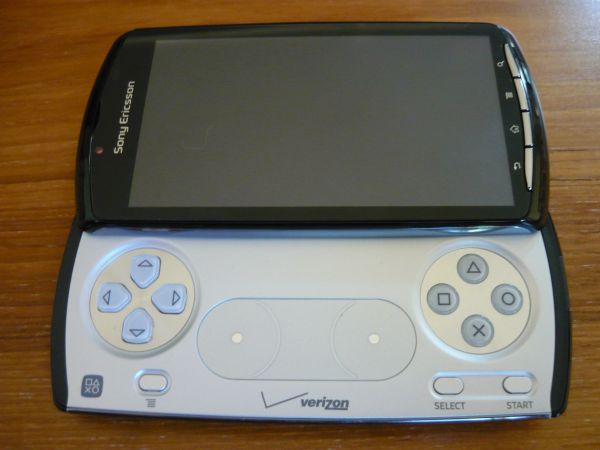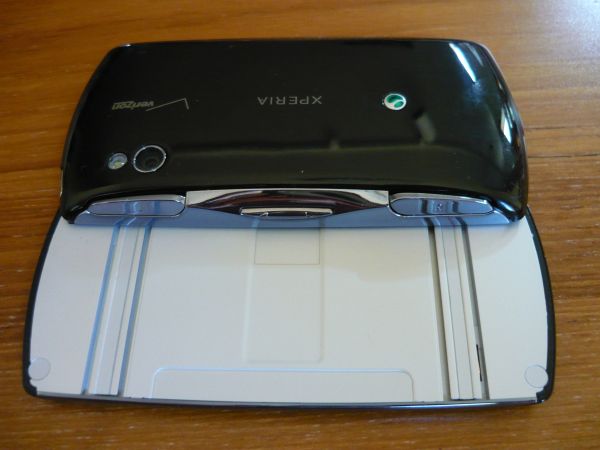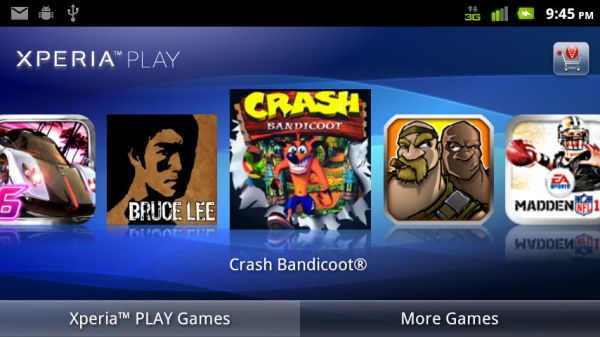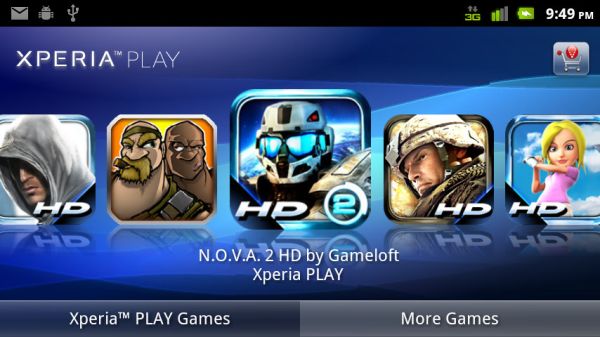The Sony Ericsson Xperia Play: Where Do You Want To Take Your Gaming Today?
by Brian Dipert on August 8, 2011 1:26 PM EST- Posted in
- Smartphones
- Sony
- Android
- Xperia Play
- Mobile
Gaming is at the core of the Xperia Play's "raison d'être," of course, so it deserves some focused editorial attention. Slide the screen up and underneath it you'll find the gamepad, which is conceptually reminiscent of a DualShock controller. You already saw this photo a few pages back; here it is again as a reminder:
On one end is a digital directional key suite, and on the other is a set of 'face' buttons. Below them are an Android 'start' button (on the left) and 'select' and 'start' buttons (on the right). Since Sony Ericsson desired to make the Xperia Play as thin as possible, there's no vertical room for DualShock-like D-Pad analog sticks or even the single, thinner analog joystick of a PlayStation Portable. Instead, Sony Ericsson substituted circular capacitive sliders, with capacitive buttons (providing, among other things, orientation-handy indents) in their centers. And where are the DualShock-like L1 and R1 controls? In normal portrait-orientation phone use, they're on one side of the Xperia Play, bracketing the volume toggle. And when you're ready to "get your game on" and landscape orientation-rotate the phone, they end up on the top edges of the lower slider layer, behind the screen.
Verizon bundles seven game titles with its version of the the Xperia Play: Asphalt 6, Bruce Lee: Dragon Warrior, Crash Bandicoot, Madden NFL 2011, Tetris, The Sims 3, and Star Battalion, accessible both standalone via the Android home screen and (with the exception of Tetris, for unknown reasons) within the Xperia Play application:
Additional content is available for download through the Xperia Play app, on a separate screen. I counted 43 titles, at a range of first-download (up to $9.99, from my limited sampling) and subscription (up to $3.49) prices. But what currently exists isn't hardware-exclusive; it's also available on other platforms:
To that point, one common complaint I read from Xperia Play owners is that they needed to re-purchase game titles they'd already bought for other Sony hardware; the existing licenses couldn't be expanded (or at least transferred) to include the Xperia Play. Folks also weren't particularly fond of the D-Pad-replacing capacitive circular pads, and I tend to concur; my success in convincing them to react in the way I intended was somewhat hit-and-miss, and the overall lack of tactile feedback versus a joystick left me overwhelmed. With that said, I'm more forgiving than some in understanding the design constraints that compelled Sony Ericsson to use them.
The bundled, Xperia Play-optimized games I auditioned generally provided an acceptable playback experience, albeit with occasional stutters on a few titles. Bruce Lee: Dragon Warrior was probably the most immersive title I tried, from both audio and visual standpoints; I say this as someone who's not even a particular fan of the action fighter genre. Flight simulation and racing games are more my cup of tea; as such, Asphalt 6 and Star Battalion didn't disappoint, either, though I generally found myself underwhelmed by the inferior richness of the Xperia Play titles (which were reminiscent to me of PlayStation 1 or Nintendo 64 content of days past) in comparison to games intended for a dedicated-function portable console.
As you'll read in detail in the sections to come, the Xperia Play's hardware allotment is modest, but leading-edge graphics drivers from Qualcomm provide the phone with more robust performance than that of its similar-component peers. Nonetheless, the dearth of compelling Xperia Play-optimized content is disappointing, and dulls the overall enthusiasm for the system. Hopefully, AT&T's recent embrace of the Xperia Play is indicative of better news to (soon) come in this regard. And speaking of hardware, a mini-HDMI output that would enable optional tethering of the Xperia Play to a television or other larger display for a more immersive gaming experience is also a notable 'miss'; perhaps if a second-generation design ever appears, Sony Ericsson will see fit to include such a capability.
Other games can be downloaded from Google's Android Market, the Amazon Market for Android, or the Verizon VCast Store. I frankly don't recommend the VCast Store, due both due to its comparatively limited selection and higher prices. Gun Bros, for example, is available for free from the Android Market; the very same title will cost you $6.99 for first download from the VCast Store, or $2.99 for re-download. These generic Android titles don't leverage the Xperia Play gamepad, of course, no matter that they play smoothly on the hardware. Fortunately, many of them harness the handset's accelerometer, as do (optionally, versus the mechanical controls) the Xperia Play-optimized titles.














34 Comments
View All Comments
name99 - Tuesday, August 9, 2011 - link
"Yes, the silver trim is plastic, not metal, ... and minimized the potential for interference-induced antenna sensitivity degradation"Do we know that this is ACTUALLY true? Or is this high school EM applied completely inappropriately?
Obviously it is true that have metal parts in a phone affects the antenna. It's just as true that
- most phones (from a whole range of manufacturers) ship with large chunks of metal in them
- Apple's portables (those with which I am most familiar) went through a phase some years ago where the plastic MacBooks had better reception than the metal MacBook pros, but that hasn't been the case for a while. And the limited knowledge I have of Win portables (or various tablets) doesn't have people all stating unanimously "buy xxx [with a plastic cover] because its radio reception is so much better than yyy [covered with magnesium or titanium or aluminum or whatever]".
I don't have a strong opinion about this either way, but it seems to me, based on behavior across a range of manufacturers that the true state of affairs is
- if you're an amateur then using plastic is probably best because you can just ignore it BUT
- if you're a professional (and pretty much every company of interest IS now professional] you just model the entire environment (metals plus dielectrics) as finite elements. optimize the antenna for that environment, and things works out as well as they realistically can.
[And, OMG, please, if you're a commenter who feels the need to pipe up about "antenna-gate" and "grips of death", ask yourself before you comment:
- does my comment add anything useful to the question that has been posed? AND
- does my comment make me look like a retarded 14yr old with poor impulse control?]
medi01 - Wednesday, August 10, 2011 - link
I worked in EM field, and what you state is utter nonsense.You can repeat "I'm a professional, very professional, superprofessional" all day long, with "it's magical, it's very very magical" on top of it, but it still won't help you to get EM waves through the metal.
Surrept - Tuesday, August 9, 2011 - link
Is this the Brian Klug that was once bitten by a fox. It only makes sense he is on the staff here. Smartest person i've ever met in the field of computers.